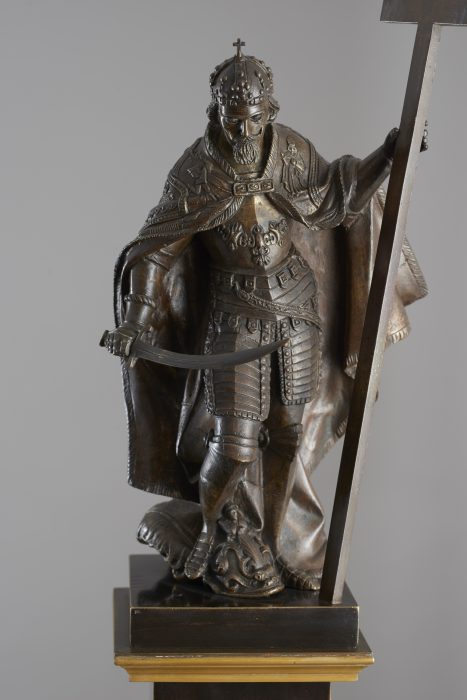
Miniature of the King Sigismund III Vasa Column
The King Sigismund III Vasa Column was the first secular monument in Warsaw and has been the most important symbol of the city for centuries. In all likelihood it is also the first early modern European monument in the form of a column raised to honour a lay figure. Its form bears reference to columns erected in ancient Rome and their early modern Italian counterparts.
The column was raised in 1644 upon the initiative of King Ladislaus IV (1595–1648, King of Poland since 1632) in honour of his father, King Sigismund III Vasa (1566–1632, King of Poland since 1587). King’s advisor Agostino Locci (1601–1660) participated in works on the design, and the monument was created by Constantino Tencalla (1610–1647), the royal architect of both Kings. The statue of the King was sculpted by Clemente Molli (d. 1678) from Bologna, and it was cast in bronze by Daniel Tym who probably hailed from Gdańsk and was active in Warsaw around 1634. He also produced the bronze decorative elements and four commemorative plates on the monument’s pedestal. The plates were cast in Warsaw, whereas the statue of the king most likely in Gdańsk. The statue portrays the king in full armour, with the chain of the Order of the Golden Fleece on his chest, in a coronation mantle, with a crown and a sabre in his right hand, whereas his left hand is supported on a large cross. The shaft of the column was originally created from a single block of red marble from Chęciny, and the king’s statue and decorative element were fire-gilded.
In 1655, the Swedish army that occupied Warsaw during the Deluge wanted to use a ruse in order to destroy the monument by moving it into a different location, yet no one was found who wanted to undertake the task of transporting it. In 1711, King Augustus II of the House of Wettin (Augustus II the Strong, 1670–1733, King of Poland 1697–1706 and 1709–1733) offered the column as a gift to the Russian Emperor Peter I Romanov (1672–1725, Emperor of Russia since 1689) during his visit to Warsaw. Yet, due to technical difficulties it proved impossible to transport it to Russia. The monument underwent conservation works in 1743 and 1810. In 1887, the marble shaft was replaced with a granite one and gilding was removed from the statue and decorations. The subsequent conservation works were carried out in the years 1929–1930. The column was hit with a missile from a tank cannon during the Warsaw Uprising on the night between 1 and 2 September 1944, and was demolished as a result.
Legend has it that when the king in the monument drops the sabre, it is a harbinger of an imminent misfortune and collapse of the city. Alas, this proved to be true in 1944. Owing to a nation-wide fund-raising campaign, the column was rebuilt and unveiled again in 1949. The reconstruction was headed by architect Stanisław Żaryn (1913–1964). The bronze statue of the King was restored by the Warsaw bronze company of the Łopieński Brothers. The column underwent conservation works in 1977, 1987 as well as in the years 1994-1996. The miniatures of the column, including the one from the collection of the Museum of Warsaw, were produced around 1950 in the workshop of Władysław Miecznik (1903–1989) for the needs of official government as official Government’s gifts.
Miniature of the King Sigismund III Vasa Column
BRONZE AND ENGRAVING WORKSHOP
OF WŁADYSŁAW MIECZNIK
WARSAW; C. 1950
BRONZE, CAST
MHW 1/JM
162 × 24 × 24 CM
Image licensed under: ![]()
